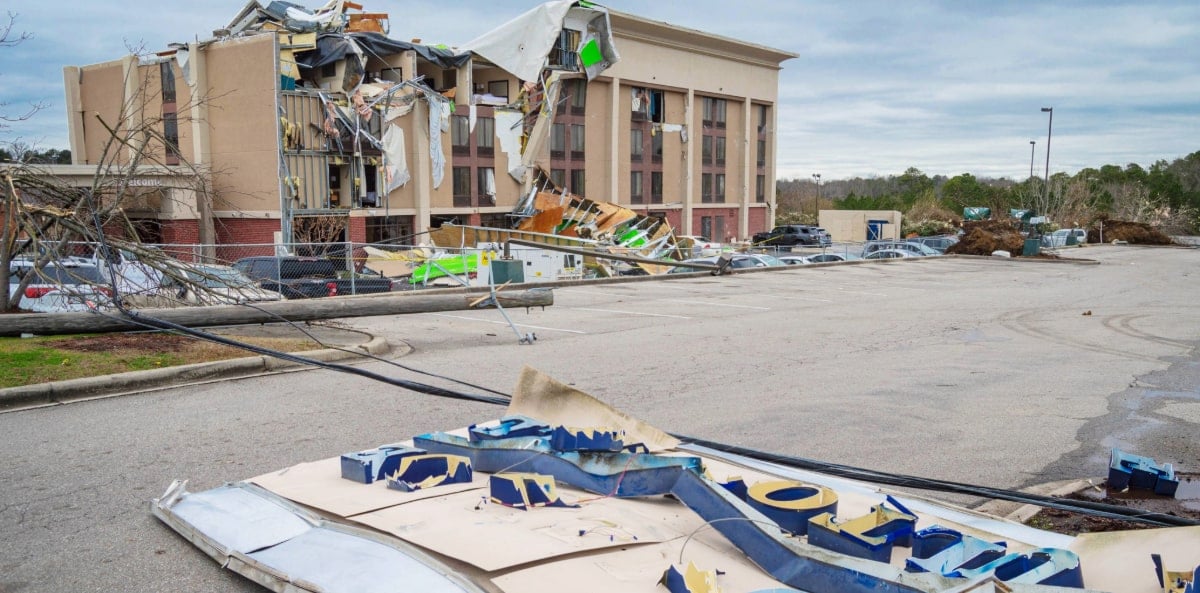Prep your business for hurricane season

A severe storm can damage or destroy your business property, drive away your customers, and make it difficult for your business to recover. The Federal Emergency Management Agency (FEMA) reports that 40 percent of small businesses fail to reopen after a disaster strikes.
Getting ready for hurricane season involves four key elements:
- Assessing your risks
- Preparing your property
- Drafting a response plan
- Making sure you’re financially protected
Continue reading to dive more into each element of a successful hurricane preparation plan.
When is hurricane season?
The Atlantic hurricane season is from June 1 through Nov. 30. In the Eastern Pacific, it lasts from May 15 to Nov. 30. Most hurricanes and severe storms tend to hit from August to October, with September being the most active month.
The hurricane forecast for the years to come
It's no surprise to many that hurricanes are worsening in severity due to global climate change.
The National Weather Service reports that there are, on average, 14 tropical storms per season, with seven of those becoming hurricanes.
Rising ocean temperatures are causing increased sea levels, higher sea temperatures, and faster wind speeds.
Hurricanes are more common and more deadly than we've seen in previous generations, according to sources such as the Environmental Defense Fund. Weather forecasters also report that increased temperatures make hurricanes more erratic and harder to predict.
Small business owners must adapt to climate change and work even harder to protect their businesses in the coming years.
Start by assessing your risk
The first step in hurricane preparation is to assess what the risk level is for your business. With FEMA’s flood map service you can input your business address and discover the flood zone for your location.
Even if you’re not in a high-risk area and 50 miles or more from the coast, you could still be at risk of damage from strong winds and rain if a hurricane makes landfall in your area.
FEMA flood maps and your local authorities could help you determine how high the water might reach, in case of storm surge or rain-induced flooding.
This can help you best prepare for a storm and how high you may need to elevate any of your business property that you’ll have to leave behind if you evacuate.
Inspect and prepare your property
Before hurricane season starts, it’s important to take a detailed look at your property and assess it for risks. You might consult with a contractor who specializes in hurricane preparedness.
You could start by having your property inspected by a general contractor or structural engineer, to make sure it can survive a storm and if there are any changes you'll need to make.
Some other measures you can take include:
- Make sure you check your walls, sheathing, windows, doors, and the roof, including any roof-mounted signs or equipment. Examine the trees on or near your property for any branches that could fall and damage your building, and have them removed if necessary.
- Check your gutters to make sure they’re in good shape, free of debris, and that downspouts are directing rainwater away from your building.
- Also look for places where you might be able to pile sandbags, to divert a storm surge or reduce its impact on your property. You can also use sandbags anywhere water might enter, such as doorways and garage doors.
- If you can, replace your doors and windows with those rated for hurricane-strength winds, including all hinges and latches. You might invest in storm shutters, or have sheets of plywood ready to install over windows and doorways.
- Even if you have wind-rated windows, you still may need window coverings such as metal shutters or plywood. Any garage or bay doors will need to be braced against impact. You should also secure any loose items or equipment that’s kept outside.
- Consider the equipment that you’ll be able to evacuate with, and what you’ll have to leave behind. Can you wrap printers and other water-damageable items in plastic and place them in a higher location? Large items, such as furniture and filing cabinets, should be anchored and secured to wall studs or something similar.
- Locate the electrical and gas shutoffs for your property, and make sure you turn them off if you evacuate. Storms will likely cause power outages and power surges, from power lines getting crossed or when the electricity is turned back on. Cutting your power supply off from the electrical grid can help avoid this.
- You should also close the shutoff valves for your sewer lines, to prevent them from backing up into your property. If you don’t have a sewer shutoff valve, consider having one installed.
Draft an emergency response and business continuity plan
A hurricane response plan is crucial to making sure your business can survive a storm, while also looking out for employee safety. When building a comprehensive plan, you should look at four key areas:
- Staying informed via weather and emergency alert programs and apps.
- Maintaining accurate and up-to-date employee records, and knowing their personal emergency plans.
- Documenting and recording all business assets and data.
- Stocking up on supplies and finalizing your hurricane checklist.
Get your employees on board with this hurricane preparedness and practice your evacuation drills, so everyone knows how to shut down your business and quickly evacuate, if the need arises.
Make sure you have everything you’ll need to secure your property ahead of time, and for disaster recovery after a storm, so you’re not scrambling for last-minute items at the hardware store.
Stay informed
Sign up for any local disaster information systems in your area. You might also sign up for weather alerts from your favorite weather app on your phone.
The National Oceanic and Atmospheric Administration’s (NOAA) National Hurricane Center offers information on active storms and related weather forecasts.
The National Weather Service offers free Wireless Emergency Alerts that you can subscribe to. It sends cell phone alerts for things like extreme weather and local emergencies that require evacuation. These notifications are sent through cell towers in an affected area, so you’ll be covered wherever you travel.
You should also be aware of evacuation routes in your area and have an idea of where you and your employees will relocate to in case of a hurricane watch, or a hurricane warning and evacuation order.
Get everyone’s details
Make sure you have contact information for all your business partners and employees, including their emergency contact information, and details on where they’ll be if you have to evacuate.
You should also have a contact list and communication plan for just about anyone you do business with. This includes any suppliers, vendors, your insurance company, policy numbers, and information on how to file a claim.
It’s also a good idea to have the contact information and phone numbers of your local emergency authorities, aid organizations (e.g. Red Cross, Salvation Army, etc.) and utility companies.
Document everything
You should have a list of all your business assets and equipment. You’ll need as much detail as possible when filing a claim and meeting with the insurance adjuster.
You might include:
- A detailed description of each item, when it was purchased, and the price
- The make, model, and serial number of each item (if available)
- Inventories of your supplies and products, with their estimated value
- Where you kept each item at your business, their estimated loss and replacement values
Take pictures and/or videos of your workplace to document the condition of your business property. All of these records and your important documents should be kept in multiple places, such as a waterproof container offsite, or with a cloud backup.
If you own a building, it would be a good idea to have it appraised regularly, such as every five years, especially if commercial property values are rising in your area. This information would be valuable to give to your insurance provider if you have to file a claim.

Draft a hurricane preparedness checklist and evacuation plan
You’ll need a checklist for how you’ll close your business and evacuate, with different tasks assigned to every member of your staff.
It’s also important to conduct evacuation drills, so everyone knows what’s expected of them and you can secure your business as quickly as possible. It also gives you a chance to make sure you’re stocked up on supplies.
Your employees will want to load their own belongings into their vehicles. Will they have room to store an external hard drive and other equipment that’s important to your business? You should make sure to have this figured out beforehand.
If your business owns vehicles, will you try to evacuate these as well? Will you loan them out to your staff, with the understanding that their own belongings and some of your business equipment will go along for the ride? Again, you should have the details finalized beforehand.
You should also make sure you have enough emergency supplies. These should include:
- First aid kits (including hand sanitizer and hygiene products)
- Ready to eat and non-perishable food
- A battery-powered weather radio
- Drinking water (at least 1 gallon per person, per day)
- Flashlights, extra batteries, and cell phone chargers
- Eating utensils, paper plates, and a manual can opener
- Emergency funds for yourself and employees (banks and ATMs could be closed for some time)
- Portable fuel pumps, hoses, and emergency generators
- Fuel and gasoline (for vehicles, cook stoves, pumps, and generators)
- Cleanup gear: large plastic bags, gloves, masks, and duct tape
How to start your post-storm recovery
While you might be anxious to return to your business after a storm passes, it’s important to wait until your state and local authorities have indicated that it’s safe to do so. Heading back before the “all clear” signal just puts yourself at risk and makes it hard for emergency responders to do their jobs.
If you have a security system, you might start by checking with your vendor to see if your property is still secure. As you return to your area, watch out for downed power lines, washed out roads, and remaining floodwaters.
NOAA reports that just six inches of water is enough to cause a loss of control and even stall most passenger cars, while a foot of water will float many vehicles. Just two feet of rushing water can carry away most vehicles, including SUVs and pickup trucks. This is one of the many reasons why you should wait to come back to your business until it's all clear.
When you return to your business, check for any signs of structural damage to the exterior that could make entering it unsafe. If you’re not sure if it’s safe, you may have to wait until a structural engineer or a building inspector confirms whether it’s structurally sound.
If you see damage to your property, contact your insurance agent right away, to get started on your claim and get set up with an adjuster.
Be sure to document all damage, both inside and outside your property, and take plenty of pictures, before you begin cleaning up.
You can take steps to secure your property and prevent further damage, such as putting a tarp on the roof or boarding up a broken window, but hold off on any serious repairs (or signing contracts) until you meet with the adjuster.
Confirm that your electrical system is dry and that reliable power is available before turning on your main circuit breakers. If you think your electrical system was been damaged, have it inspected by an electrician before turning the power back on.
Examine your business property to determine what can be salvaged and what should be thrown away, while documenting all of this for your insurance claim.

Have the right insurance coverage to manage your hurricane risks
There are a few types of business insurance policies that any business owner should consider, especially if you live in an area frequented by tropical storms and hurricanes:
General liability insurance covers common business risks like customer injuries, customer property damage, advertising injuries, and copyright infringement.
Commercial property insurance protects your business’s physical location, equipment, and supplies.
Most commercial property policies cover wind and hail damage, although it’s important to verify this with your insurance provider. You should also make sure your policy includes damage from wind-driven rain. If these coverages aren’t included, you might be able to add them to your commercial property coverage through an insurance endorsement.
Business interruption insurance, also known as business income insurance, covers your lost income if you have to temporarily close your business because of a catastrophic event, such as a fire or hurricane. It can cover your lost revenues, rent, and relocation costs.
Depending on your business location, parametric insurance is another option that may be available for hurricane coverage. This policy relies on predefined triggers in the form of measurable events, such as wind speeds exceeding 100 mph.
What about commercial flood insurance?
You’ll likely need commercial flood insurance if your business is vulnerable to any type of flooding, such as hurricanes, storm surges, or rivers overrunning their banks.
Commercial flood insurance can be obtained through the National Flood Insurance Program (NFIP), administered by FEMA. There are two types of flood insurance available:
- Building coverage insures against the damage and loss of your commercial building from flooding.
- Contents coverage is for the loss of any business equipment and inventories within the building itself.
For commercial properties, you can buy flood insurance coverage of up to $500,000 for the building and $500,000 in contents coverage.
If you rent your business space, your landlord may have flood insurance for the building itself but probably doesn’t have contents coverage. You may need to buy contents-only coverage for your business if you want to be fully insured against a flood.
You can obtain federally-backed flood insurance through the government’s flood insurance portal, or by calling the NFIP at 877-336-2627.
What is the anti-concurrent causation clause?
When a property is damaged during a tropical storm or hurricane, it can be hard to figure out how much damage was caused by high winds, rain, or flooding.
For example, imagine if hurricane-force winds damage or remove your roof, allowing rain to soak your property. At the same time, a storm surge enters your building and causes damage.
It would be hard to tell out how much water damage was caused by rain (covered by property insurance) and how much was caused by rising groundwater or a storm surge (covered by flood insurance).
The anti-concurrent causation clause means that if there are two kinds of damage to your property and one of them is excluded from your coverage, an entire claim could be rejected.
If you had both commercial property and flood insurance, it would be up to the insurance companies to figure how much damage should apply to either policy. If you only had one of these policies, you could have a hard time proving to your insurance company that all the damage was caused by either wind and rain, or flooding.
That’s why it’s so important for businesses in hurricane-prone areas to have both commercial property and flood insurance. By making sure you’re fully covered against all hurricane-related perils, you avoid this potential gap in coverage.
How does a hurricane deductible work?
A hurricane deductible applies to your commercial property insurance and goes into effect when the National Weather Service declares that a weather system has become a named storm, such as a hurricane, typhoon, or tropical storm, with a name or number.
Hurricane deductibles typically range from 2% to 10% of your property insurance coverage. For example, a 5% deductible on a $500,000 policy means the owner would have a deductible of $25,000 in the event of a named storm or hurricane.
This deductible applies to any named storm that happens within a calendar year, as long as you keep your coverage.
Once you meet your hurricane deductible, then the regular “all other perils” deductible for your commercial property coverage would apply to any additional storms that year.
If a second storm arrives, and you didn’t meet your deductible during the first storm, then either the remainder of your hurricane deductible or your “all other perils” deductible would apply—whichever is greater.
What is the wind and hail deductible?
Most damages that are covered by your commercial property insurance have a standard deductible that’s set at a specific amount.
For example, if you had $50,000 in fire damage with a $1,000 deductible, you would pay that $1,000 deductible and the insurance company would cover the rest.
A wind and hail deductible applies only to wind and hail damage at your property and is set at a percentage of the total damage cost, usually between 1% and 5%.
If you had $50,000 in wind and hail damage at your property and a 5% wind or hail deductible, your deductible would be $2,500 before your insurance coverage kicks in.
Get free small business insurance quotes from trusted carriers with Insureon
Complete Insureon’s easy online application today to compare insurance quotes from top-rated U.S. carriers. You can also consult with an insurance agent on your business insurance needs. Once you find the right coverage for your small business, you can begin coverage in less than 24 hours.
Mike Mosser, Content Specialist
Mike spent several years as a reporter and editor covering politics, crime, and the world financial markets. He’s worked for several newspapers, a financial newswire, and a monthly magazine. As a copywriter, Mike has produced SEO-based content, marketing, public relations, and advertising work for a variety of companies.









